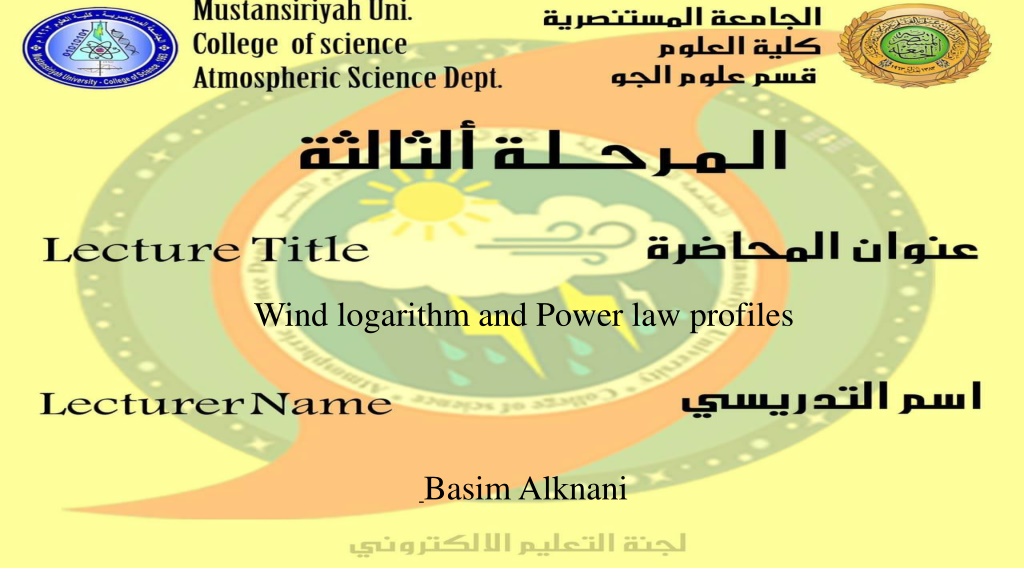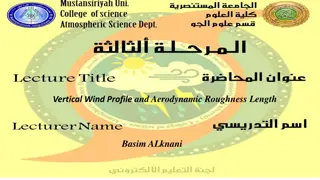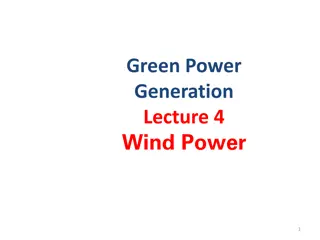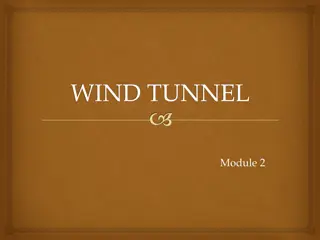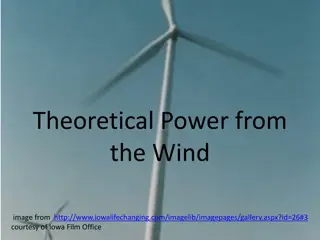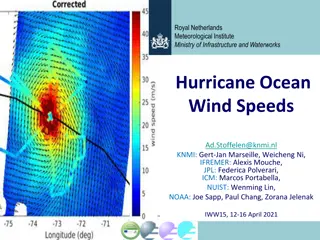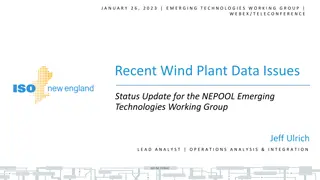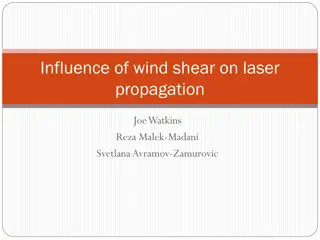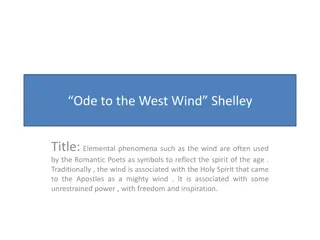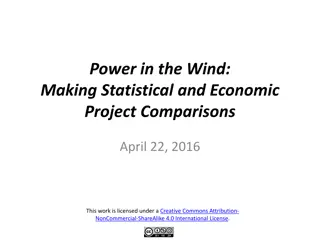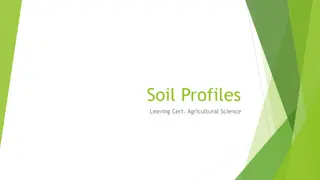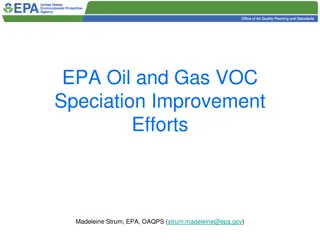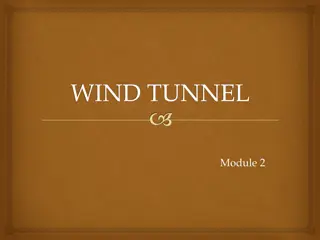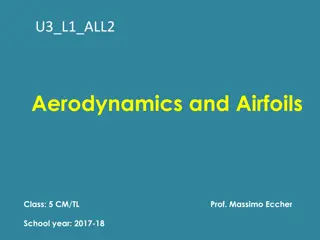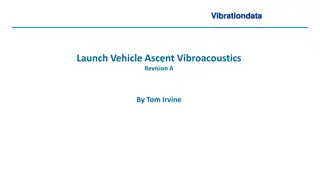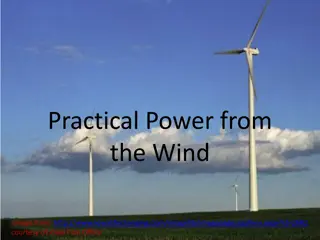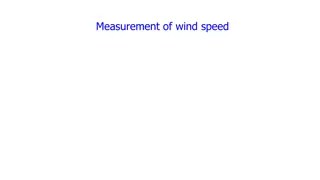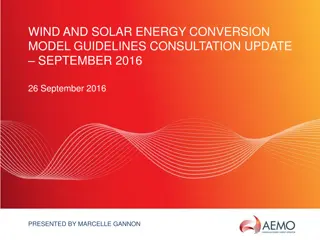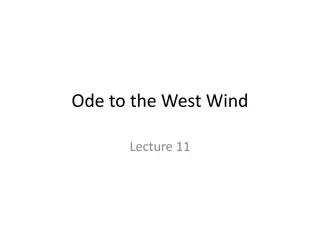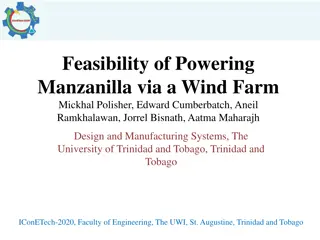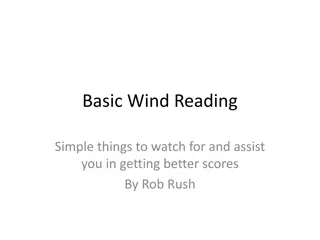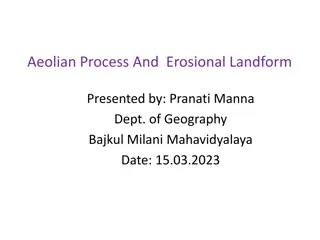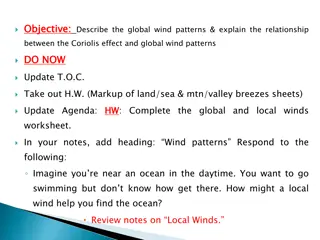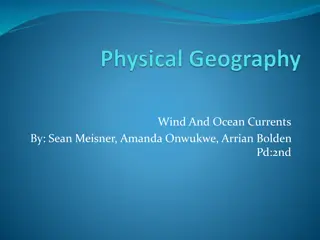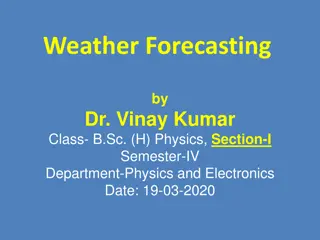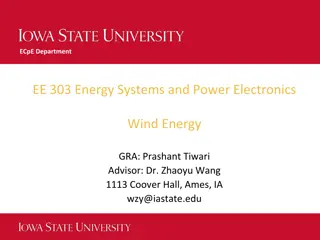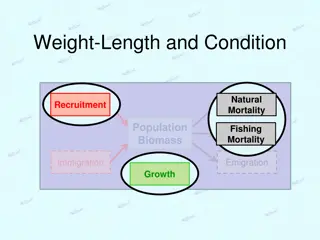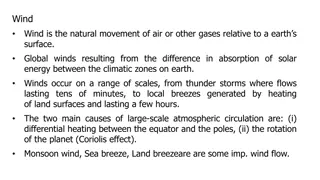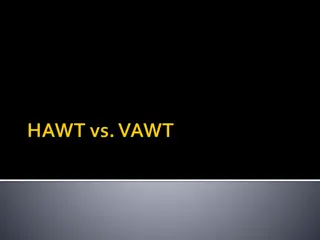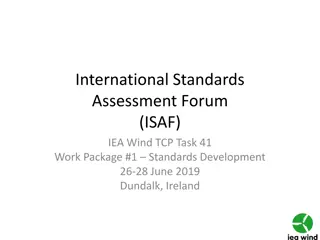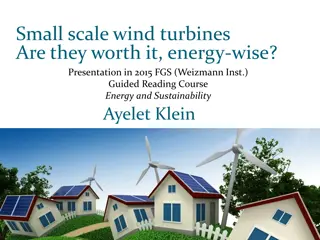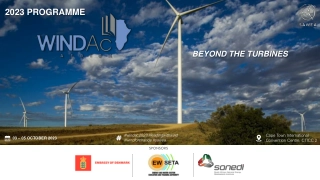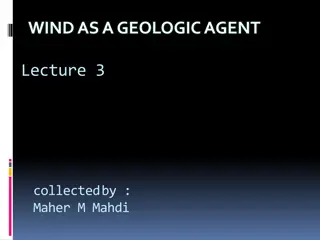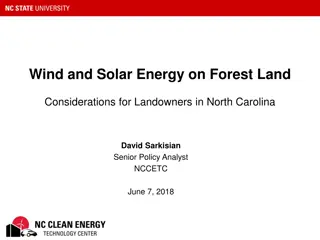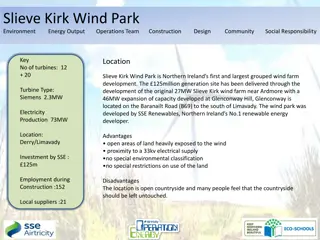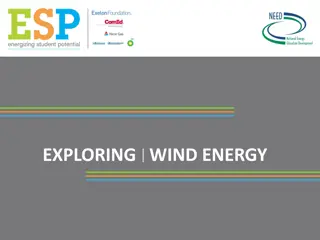Understanding Wind Profiles and Aerodynamic Roughness Length
Wind profiles are crucial in understanding how wind speed changes with height in the boundary layer. The logarithmic and power law profiles depict this relationship, influenced by surface characteristics and obstacles. The aerodynamic roughness length, defining where wind speed becomes zero, remains constant for a given surface. Friction velocity and momentum flux play key roles in describing the drag force exerted by wind. Different mathematical models, like the Logarithmic and Power Law profiles, are used to model wind speed variations over flat terrains. Understanding these concepts is essential in environmental studies and urban planning.
Download Presentation

Please find below an Image/Link to download the presentation.
The content on the website is provided AS IS for your information and personal use only. It may not be sold, licensed, or shared on other websites without obtaining consent from the author. Download presentation by click this link. If you encounter any issues during the download, it is possible that the publisher has removed the file from their server.
E N D
Presentation Transcript
Wind logarithm and Power law profiles Basim Alknani
Vertical Wind Profile in boundary layer Wind speed is zero at the surface and increases sharply in the near surface layer such that the wind speed increases exponentially with height . The shape of the profile is influenced by the nature of the underlying surface, the surrounding topography and nearby obstacles. ?? ?? 1 2 Wind speed shows an increase with respect to height and as such it is generally beneficial to discharge pollutants at a greater height as dispersion is greater. The rate of change with height (known as wind shear) is greatest near the surface.
Aerodynamic Roughness Length: the aerodynamic roughness length, z0, is defined as the height where the wind speed becomes zero. the aerodynamic roughness length is determined for a particular surface, it does not change with wind speed, stability, or stress. it can change if the roughness elements on the surface change such as caused by changes in the height and coverage of vegetation, manufacture of fences, construction of houses, deforestation or lumbering, etc. Letta (1969) suggested a method for estimating the aerodynamic roughness length based on the average vertical extent of the roughness elements (? ), the average vertical cross section area obtainable to the wind by one element (S?), and [ SL = (total ground surface area / number of elements)]. ? ?0 = 0.5 (S? ?/ /? ?? ?) (1.1) This relationship is acceptable when the roughness elements are evenly spaced, not too close together, and have similar height and shape. Kondo and Yamazawa (1986) proposed a similar relationship, where variations in individual roughness elements were accounted for. (Si) represent the actual horizontal surface area occupied by element (i), and (hi) be the height of that element. if (n) elements occupy a total area of (St), then the roughness length can be approximated by: ? ?? = ?.?? ???? (?.?) ?? ?=? these expressions have been applied successfully to buildings in cities.
Friction Velocity The momentum flux (i.e. momentum transfer per unit area) is also known as the shear stress or the drag force. The dimensions of drag are in [N m-2]. In the atmospheric surface layer, wind always increases with height and the momentum transfer is always downwards. the drag is a force on the surface along the direction of the wind. The friction velocity, (? ), is defined as ? . (1.4) ? ? = shear stress, (?). (? ) is not the speed of the flow but simply another expression for the momentum flux at the surface. (? ) air density . The shearing stress exerted on a surface by fluid flow is generated within the boundary layer and transmitted downwards to the surface in the form of a momentum flux. ( shearing stress can be expressed , force per unit area , or momentum per unit area per unit time ) . ? 2 ?(?)2 (C?) ???? ??????????? C? =
There are two mathematical models that are widely used to model the vertical profile of wind speed over regions of homogeneous and flat terrain, which are : a- Logarithmic Law profile. b- Power Law profile. Wind logarithmic profile in Statically Neutral and Non-Neutral Conditions: To estimate the mean wind speed u(z), as a function of height, z, above the ground, we speculate that the following variables are relevant: surface stress (represented by the friction velocity, u*, and surface roughness (represented by the aerodynamic roughness length, z0. To determine wind speed (?) at a height ? , it is commonly expressed as follows: ? ? = (? ??) 1.5 )ln(?
Where (?) is the elevation above the ground,(??)is the surface roughness length, and ( =0.4) is von Karman constant 1 2) is defined as the friction velocity, where ( )is the density of the air and ( ) is the surface value of the shear stress. The roughness length (??) describes the roughness of the ground or terrain where the wind is blowing. There are cases where wind speed (?1)is known at a reference height (?1) and required at another (?2) in a case that can be derived from equation (1.5): (in neutral conditions) ??(?2) ??(??) ??(?1) ??(??) 1.6 The Businger Dyer Relationships can be integrated with height to yield the wind speed profiles ? ? =? ??) (z/L) 1.7 ? ? .( ? = ?2= ?1 ?ln(? Where (L) is the Obukhov length and the function (?/?) is given for stable conditions (z/L > 0) by : (?/?) = 4.7 (?/?) . 1.8 And for unstable (z/L < 0) by: (?/?) = 2ln[(1+?)/ 2] ln[(1+?2)/ 2] +2??? 1(?)-? /2 . 1.9 Where ? = [1 (15 ?/?)]1/4.
The Power-Law wind Profile The power - law equation is a simple, yet a useful model of the vertical wind profile which was first proposed by Hellman (1916) . The power - law profile assumes that the ratio of wind speeds at different heights can be found by the following equation: ? ?2 ?1 ?2= ?1 1.10 Where(?1) is the wind speed at a reference height (?1) (anemometer height), (?2) is the wind speed at a height (?2) (hub height), and ( ) is the shear exponent (dimensionless parameter),itis found to depend on both the surface roughness and stability. the shear exponent also increases with increasing stability .
The shape of the power law profile is determined by (), and the shape of the log law profile is determined by the roughness length (zo). Figure (2.5) depicts both types of profiles (a) Log law (b) power law Figure 2.5: Example wind shear profiles using Log law and power law models
2. Estimating the Power Law Exponent () 2.1Estimating ( ) Using Measurements at Two Heights Estimating the exponent ( ) becomes easy if the wind speeds at two heights are known, so equation can be rearranged in terms of ( ): ? =??(?2) ??(?1) ??(?2) ??(?1) The exponent ( ) is a dynamic value that depends on the surface roughness and the atmospheric stability. 2.2 Shear Exponent Constant ( ) The wind shear exponent can be taken as a constant for a certain height in a given height range. Shear exponent strongly depends on the roughness length, this exponent increases when the roughness of the terrain increases, and decreases when height increases. By choosing suitable ( ), based on measurements, Davenport (1960) suggested typical shear exponent values (1/7, 1/3.5 and 1/2.5) for three roughness classes: grassland, forest and city. An exponent of approximately (1/7) is commonly used to describe atmospheric wind profiles over the range (up to 100 m), sufficiently during near-neutral conditions, and low surface roughness. This called the one: seventh power law and it can be written as follows 1 7 ?2 ?1 ?2= ?1
2.3 The Roughness Length Method The exponent ( ) of the power law profile can be calculated from the roughness length . 1 = ?1 ?2 ?? ?? There is another method used to estimate the shear exponent, which is: 1 = ?2 ?? ln
HOMEWORK 1 Q1 ) write a mathematical expression of the following: 1- Wind speed logarithmic equation in stable conditions. 2- Wind speed logarithmic equation in unstable conditions. 3- Wind speed logarithmic equation in neutral conditions. 4- power-law equation for wind profile
HOMEWORK 2 Q2 ) write a mathematical expression of the following: 1- The aerodynamic roughness length equation when the roughness elements are evenly spaced. 2- The aerodynamic roughness length equation which uses in an urban city 3- Displacement distance equation . 4- Friction velocity equation . 5- ??????????????? equation .
